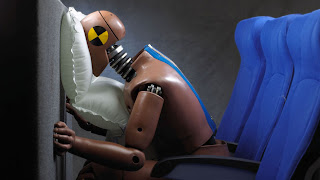Federal Agency Endorses Aviation Airbags for private jets
Follow-up : http://aviationreport.blogspot.com/2010/06/airplane-airbags.html
Federal accident investigators issued a report Tuesday strongly endorsing aviation air bags as a potentially far-reaching safety enhancement to reduce fatalities and injuries in private plane crashes.
But as expected, the National Transportation Safety Board didn't recommend mandatory implementation of such technology, which already is installed on the majority of recently-built general aviation aircraft but hasn't been retrofitted on older models. Overall, only about 7,000 of the roughly 200,000 general aviation aircraft licensed in the U.S. are now equipped with air bags.
At the end of the safety board's session, Chairman Deborah Hersman called on manufacturers to voluntarily provide air bags as standard equipment on more private planes rolling out of their factories. Reflecting the board's growing support for expanding the technology to tens of thousands of other aircraft built long before the equipment was developed, Ms. Hersman encouraged aircraft owners "to use the power of the purse and push for even greater availability of these injury preventing devices."
Tuesday's findings were the first detailed, industry-wide assessment of how effectively air bags protect pilots and passengers when private aircraft crash. The devices came on the market seven years ago, but their use didn't reach significant levels until a few years later.
As part of the board's three-year study, experts didn't find any of the devices that deployed at the wrong time, were defective or had unintended negative results. "When adjusted correctly," according to the board, air bag deployments "did not result in any negative consequences" and in some accidents, they "mitigated the severity of the occupant injuries."
Among other things, the board recommended that air bag-equipped aircraft also have devices able to record and save details about impact forces in the event of a crash.
The analysis also reiterated one of the board's long-standing priorities in this arena: the safety benefits of using shoulder harnesses, rather than just lap belts, to protect occupants of general aviation aircraft.
After examining some 37,000 single-engine airplane accidents over three decades, experts concluded that occupants using lap belts by themselves were 50% more likely to be killed or seriously injured than those protected by a combination of lap belts and harnesses.
As a result, the board called for revised federal safety standards to ensure the proper use and adjustment of all restraint systems. It also reiterated recommendations that the Federal Aviation Administration, which alone has authority to mandate safety fixes, require shoulder harnesses to be retrofitted on all private planes.
Aviation air bags devices typically deploy from shoulder harnesses, so proper adjustment of harnesses can be an important factor in saving lives.
Industry experts estimate that of the roughly 1,600 annual private plane accidents nationally, perhaps up to one-quarter could become more survivable with bags onboard.
Before the report was released, Joseph Kolly, head of the NTSB's office of research and engineering, said "this is where the safety board can really make an impact" by advocating widespread use of air bags and reassuring both private pilots and industry officials that the systems haven't shown performance problems or demonstrated any unintended safety threats.
Board officials believe as many as one out of four of small planes don't have shoulder belts or harnesses, which can cost hundreds of dollars to install per seat. Putting on air bags can cost between $1,000 and $2,000 per seat, depending on the specific model and whether the system is originally factory-installed or retrofitted on an older aircraft.
Such retrofits "may not be cheap" from the vantage point of the average private pilot, according to Ms. Hersman, but they are good investments "when you consider (them) relative to the safety benefit" and the total cost of an aircraft which can exceed $500,000.




Comments
Post a Comment